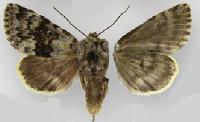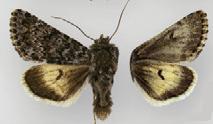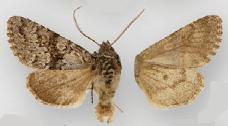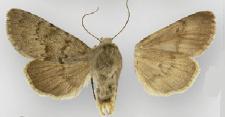
Lasionycta is a genus of moths of the family Noctuidae.

Lasionycta staudingeri is a moth of the family Noctuidae. It can be found from Oppland to Finland and Norway in Europe, as well as Siberia and North America.

Lasionycta leucocycla is a species of moth of the family Noctuidae. It can be found in Scandinavia, Siberia and northern North America.

Lasionycta skraelingia is a moth of the family Noctuidae. It has a Holarctic distribution, occurring from Scandinavia to north-western North America. In North America this species is known from three specimens from Windy Pass, Ogilvie Mountains, Yukon.

Lasionycta taigata is a moth of the family Noctuidae. It occurs in open peatlands and fens in the taiga zone from Labrador, Churchill, Manitoba, and central Yukon, southward to northern Maine, northern Minnesota, and south-western Alberta.

Lasionycta phaea is a moth of the family Noctuidae. It is an arctic species and has been collected from Baffin Island in north-eastern Canada to the central Brooks Range in northern Alaska and southward along the west coast of Hudson Bay to Arviat, Nunavut.

Lasionycta fergusoni is a species of moth in the family Noctuidae. It is found from the southern Washington Cascades through British Columbia and Alberta to southern Yukon.

Lasionycta luteola is a moth of the family Noctuidae. It is found from northern Washington and south-western Alberta northward to south-western Yukon.

Lasionycta coracina is a moth of the family Noctuidae. It is found in the Richardson and British Mountains in northern Yukon, adjacent Northwest Territories, and Cape Thompson in north-western Alaska.

Lasionycta poca is a species of moth in the family Noctuidae first described by William Barnes and Foster Hendrickson Benjamin in 1923. It is found throughout the Rocky Mountains of Alberta, westward to the Coast Range in western British Columbia and southward in the Cascades to Okanogan County, Washington.

Lasionycta illima is a moth of the family Noctuidae. It is found from Pink Mountain in north-eastern British Columbia through southern Yukon to eastern Alaska.

Lasionycta frigida is a moth of the family Noctuidae. It has a restricted range in the Alberta Rocky Mountains. It is possibly also present in Yukon and Alaska.

Lasionycta perplexa is a moth of the family Noctuidae. It is widely distributed from southern Alaska and Yukon in the north to California, Utah, and Colorado in the South. A disjunct population is found on the east coast of Hudson Bay at Kuujjuaraapik.

Lasionycta perplexella is a moth of the family Noctuidae. It is found from southern Yukon to southern Alberta and southern Washington.

Lasionycta subfuscula is a moth of the family Noctuidae. It is found from south-western British Columbia and south-western Alberta south to southern Oregon in the west and to southern Colorado and Utah in the Rocky Mountains.

Lasionycta quadrilunata is a species of moth in the family Noctuidae. It is found from south-central Alaska down the spine of the Rocky Mountains to Colorado.

Lasionycta uniformis is a species of moth in the family Noctuidae. It is widely distributed in the mountains of western North America. It occurs from southern Yukon to northern California and Colorado, with an isolated population in eastern Quebec.

Lasionycta caesia is a moth of the family Noctuidae. It occurs in the Cascade Mountains of northern Washington and the British Columbia Coast Range to 58 degrees north latitude.

Lasionycta promulsa is a moth of the family Noctuidae. It occurs from Rampart House in northern Yukon to south-western British Columbia in the west and southern New Mexico in the Rocky Mountains.

Lasionycta impingens is a moth of the family Noctuidae. It occurs from southern Yukon to Colorado.
This page is based on this
Wikipedia article Text is available under the
CC BY-SA 4.0 license; additional terms may apply.
Images, videos and audio are available under their respective licenses.



